MILES AWAY: - National Alliance for Caregiving
MILES AWAY: - National Alliance for Caregiving
MILES AWAY: - National Alliance for Caregiving
You also want an ePaper? Increase the reach of your titles
YUMPU automatically turns print PDFs into web optimized ePapers that Google loves.
distance constrains their contact with an ill family<br />
member and limits the caregiver’s ability to interact<br />
with this person regularly.<br />
As mentioned be<strong>for</strong>e, some previous research<br />
suggests that distance is a key, if not the primary,<br />
factor in determining the role of the family member<br />
in the caregiving situation. Our sample illustrates<br />
the confounding role distance plays in caregiving.<br />
With the exception of the long-distance caregivers<br />
who report that they are the only care providers,<br />
distance is related to the intensity of the caregiver’s<br />
role. Table 8 below shows that the respondents<br />
who describe themselves as the main helper live<br />
closer than those who say they are sharing the care<br />
equally. Similarly, those who report they are sharing<br />
equally are closer than the respondents who<br />
report they are primarily helping another person.<br />
Table 7. Distance and the Role of the<br />
Long-Distance Caregiver<br />
Role of Respondent<br />
Only Helper<br />
Main Helper<br />
Shared Equally with Other(s)<br />
Others Have Been Main Helper with Some<br />
Help From Respondent<br />
Average Miles from<br />
Care Recipient<br />
424.37 Miles<br />
242.17 Miles<br />
378.63 Miles<br />
554.64 Miles<br />
Distance between respondents and care recipients<br />
did not differ by gender or age. Men and women<br />
reported similar distances and, with the exception<br />
of those who were older than 65, the different age<br />
groups reported similar distance patterns. Table 8<br />
displays average distances by age group.<br />
Table 8. Distance and Age of Caregiver<br />
Age Category<br />
of Caregiver<br />
18-29<br />
30-49<br />
50-64<br />
65+<br />
All Ages<br />
Average Miles from<br />
Care Recipient<br />
425.17 Miles<br />
456.17 Miles<br />
469.90 Miles<br />
327.73 Miles<br />
450 Miles<br />
10<br />
Table 9. Distance and Frequency of Visiting<br />
Frequency<br />
of Visits<br />
Few Times a Week<br />
Once a Week<br />
A Few Times a Month<br />
Once a Month<br />
Once Every Few Months<br />
A Few Times a Year<br />
Average Miles from<br />
Care Recipient<br />
45 Miles<br />
66 Miles<br />
186 Miles<br />
334 Miles<br />
751 Miles<br />
1231 Miles<br />
There are no significant distance differences related<br />
to the number of hours respondents report<br />
spending on arranging needed services, supervising<br />
or monitoring these services or helping with<br />
personal care needs. However, those who live between<br />
1 and 3 hours from the care recipient report<br />
fewer hours (20 hours a month) helping around<br />
the home of the care recipient than those who live<br />
more than 3 hours away (25 hours a month).<br />
Looking at the relationship between distance and<br />
workplace accommodations, we see a more complicated<br />
picture. Those who report that they have<br />
had to come in late or leave early from work live<br />
nearer to the person they are helping than those<br />
who didn’t have to come in late or leave early.<br />
Those who reported that they had to miss days of<br />
work as a result of their care responsibilities lived,<br />
on average, farther from the person they helped<br />
than those who did have to miss work days. And,<br />
<strong>for</strong> those respondents who had to take an unpaid<br />
leave, turn down a promotion or work travel or<br />
who lost benefits at work, distance seemed to play<br />
a role in these work-related decisions. Table 10<br />
illustrates the average distance between the caregiver<br />
and the care recipient <strong>for</strong> those groups of<br />
respondents who reported specific work effects<br />
and those who did not.









